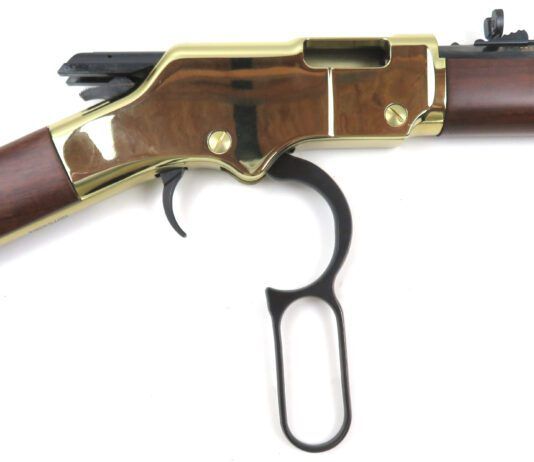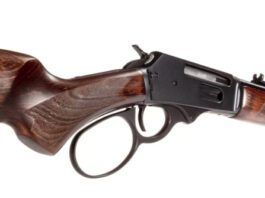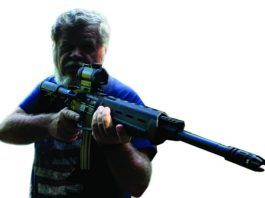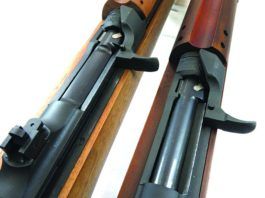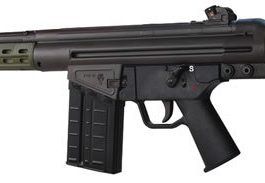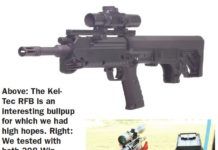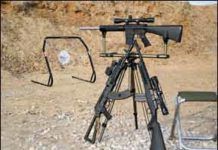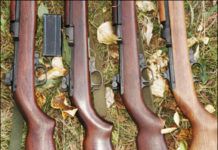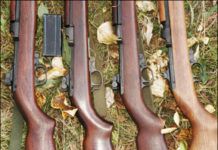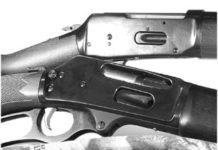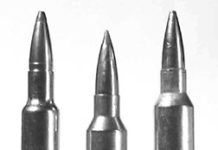Disappointing: Kel-Tecs RFB 7.62 Forward-Ejecting Bullpup
With much hype and anticipation, we took Kel-Tec CNC's RFB forward-ejecting bullpup rifle to the range 18 months ago to compare it with other bullpup-style rifles we've reviewed. This being the only 30-caliber bullpup we've tested so far, most of our shooters were eager to get behind the scope and send rounds downrange. Taking any bullpup to the range always draws some attention, and the Kel-Tec RFB was no different. The gun has a striking overall appearance, especially with the Nikko-Sterling 3-10x42 Nighteater scope we mounted on ours.
30-Caliber Carbines: SSKs 300 Whisper Speaks Volumes
Despite the long-standing availability of the AR-10, 30-caliber semi-automatic rifles continue to be less popular than the 5.56mm/223 Rem. AR-15 little brother. But just like the high-capacity 9mm pistol led to the popularity of more powerful high-capacity handguns, we're still interested in finding a good 30-cal carbine.
Our latest acquisitions in this quest began with Ruger's newest 7.62x39mm Mini-Thirty carbine, the $921 No. 5854. We wanted to see if shortening the barrel to a hair over 16 inches would make it a better choice. For the AK-47 adherents, we added a $1270 Colorado Shooting Sports Custom Combat Gen 2 AK-47 that featured the addition of a Lightning Bolt and Lightning Lever for improved combat readiness. Our third gun chambered the 300 Whisper, a round designed to be fired through a suppressor. Built by SSK Industries, this was a $1300 AR-15 platform capable of shooting both high-velocity and subsonic velocity rounds with the twist of a screw in the handguard.
Since our primary interest was close quarters battle, our accuracy tests were limited to benchrest shooting from the 50-yard line. But we also challenged the SSK Industries 300 Whisper to longer distances to learn more about this cartridge.
In addition, we had some very specific questions to answer that had more to do with the general "shootability" of these carbines, including rapid fire. We got some help practicing for shots of record from a couple of new products from Battenfeld Technologies.
They were Caldwell's $130 Dead Shot Field Pod and the $170 Magnum Rifle Gong. The Field Pod is an ultra lightweight collapsible shooting rest with a carry sling. We especially liked the gong because its frame broke down to 5 easy-to-carry pieces plus the durable AR550 steel plate. Ringing the gong gave our test evaluators immediate feedback and we didn't have to paste up targets. It was a lot of fun for our testers, too.
For optics we mounted the same Springfield Armory 3-9X40mm A.R.T. IV variable power scope on both the Ruger and SSK Industries carbines. The Colorado Shooting Sports AK-47 utilized a forward mount with an Aimpoint CompML2 with 4-MOA red dot mounted and sighted in by CSS. It seemed ideally suited to the weapon and was a better choice than any long-relief scope we could supply. In view of our relatively short test distance, we chose to leave it in place.
For ammunition we utilized four different rounds of 7.62x39mm ammunition. They were 124-grain soft point Wolf Military Classic, 124-grain FMJ American Eagle, Remington UMC 123-grain Metal Case, and Winchester 123-grain full-metal-jacket rounds. Our 300 Whisper ammunition consisted of three Cor-Bon rounds and three Hornady rounds. The Hornady rounds were the 110-grain VMax, 208-grain AMax, plus a handload topped with a Hornady 169-grain hollowpoint boattail bullet. The Cor-Bon rounds were 125-grain jacketed hollowpoint rounds, 220-grain Subsonic rounds and a 150-grain jacketed soft point. Unfortunately, we had difficulty chambering the 150-grain JSP rounds and returned them to Cor-Bon for analysis.
Classic Police Self-Loaders: Model 8 Versus Model 1907
Around the turn of the previous century there was a rapid advance in firearms design. Among the great changes was the popularity of self-loading rifles. While the lever-action rifle and the single-action revolver were used by Western lawmen well into the century, officers confronting armed gangs felt a need to get themselves on a level playing field with the criminal element. A relatively short and handy self-loading rifle was just the ticket for use against thugs armed with a variety of weapons and traveling in sheet-metal vehicles. The rifles we are comparing in these pages also had sporting use, and they were used widely by outdoorsmen. But cops, federal agents, and prison guards were the primary users of these firearms. The Remington Model 8, in particular, was used by hunters, and remains popular as a Northeastern woods gun. The Winchester 1907 saw considerable military use. Several thousand were used in World War I, a drop in the bucket compared to some designs, but important for Winchester.
Four M1 Carbines: CMP, Fulton, And Auto-Ordnance Compete
The M1 carbine was the most prolific U.S. weapon of the WWII era, with six-odd million made, and it's still very popular today. It employs an anemic round by rifle standards, but—per its design—its cartridge is at least as powerful as most handgun rounds. Today's buyer of a genuine WWII-era or Korean War era carbine will probably need to spend around a thousand dollars, give or take a few hundred, for a reasonable example. On GunBroker we saw prices from about $750 to$1400, depending on condition and rarity. However, if you're qualified, and if you hurry, you may be able to get a decent carbine for about $420-675, through the Civilian Marksmanship Program (CMP) sales. This outlet used to be called the DCM, Director of Civilian Marksmanship, run by the U.S. government, but that program is now in private hands. However, due to the nature of the program, the CMP carbines may be in very short supply by the time this report appears in print.
Do you qualify for a CMP firearm purchase? Taking the CMP requirements straight from the website (www.thecmp.org), "By law, the CMP can sell surplus military firearms, ammunition, parts and other items only to members of CMP-affiliated clubs who are also U.S. citizens, over 18 years of age and… legally eligible to purchase a firearm." For more information, visit the website.
For this test we acquired four carbines. We had on hand a Fulton Armory carbine, with an original Underwood barrel in near-perfect condition. But if you want a Fulton-built M1 carbine today you'll have to get it with the new Fulton barrel ($1300). All of the original mil-spec barrels are apparently now gone. Two of our carbines came from the CMP, both "Service Grade." One was an Underwood (CMP-1, $565) and the other an Inland (CMP-2, $ 495). The so-called "Rack Grade" carbines are a bit less expensive. Finally, we acquired a new Auto-Ordnance AOM130 M1 Carbine ($899) with beautiful walnut stock and newly manufactured metalwork.
In our testing of these four M1 carbines, we found many similarities and a few differences. There were two types of safeties. One was the swinging-arm or "flip" type, which requires pulling a small lever rearward to put the gun into the firing position. This is easily accomplished with the right index finger, by right handers, and fairly easily by the trigger finger of lefties. The second safety type was the crossbolt, similar to that found on many pump shotguns. This required pressing to the left to fire, which we found could not be done as easily by lefties. The Auto-Ordnance and Underwood (CMP-1) carbines had the push-button safety. The Auto-Ord and Underwood also had the flat bolt, and neither of these two had a bayonet lug. All the guns except the Auto-Ord had the stepped, windage-adjustable rear sight. The A-O had a modern-made, two-height sight similar to the original M1 carbine sight, which had to be drifted for windage. The two CMP carbines had a stamped base for the adjustable rear sight. The Fulton had a milled base. The Underwood (CMP-1) had a sheet-metal trigger guard. All had the wing-protected front sight.
We tested with three types of 30 US Carbine FMJ "ball" ammunition, all of it 110-grain loads. It was from Sellier & Bellot, American Eagle, and original U.S. Mil-Spec ball (head stamped LC71). Because the two CMP carbines came without magazines, we used an original Winchester 15-round magazine for all our testing, with one exception explained below.
Generally speaking, here's what we think. Those who like shooting military type firearms really owe it to themselves to have an M1 carbine. They're a lot of fun. Good ones need not break the bank, but in an era where the SKS rifles that used to go begging at gun shows for $85 now bring upwards of $400, the price of an M1 carbine is not outlandish, even at the over-a-grand mark. We suggest you act soon, particularly if you want one from the CMP. They're going fast.
Details on the four guns we tested follow:
Four M1 Carbines: CMP, Fulton, And Auto-Ordnance Compete
The M1 carbine was the most prolific U.S. weapon of the WWII era, with six-odd million made, and it's still very popular today. It employs an anemic round by rifle standards, but—per its design—its cartridge is at least as powerful as most handgun rounds. Today's buyer of a genuine WWII-era or Korean War era carbine will probably need to spend around a thousand dollars, give or take a few hundred, for a reasonable example. On GunBroker we saw prices from about $750 to$1400, depending on condition and rarity. However, if you're qualified, and if you hurry, you may be able to get a decent carbine for about $420-675, through the Civilian Marksmanship Program (CMP) sales. This outlet used to be called the DCM, Director of Civilian Marksmanship, run by the U.S. government, but that program is now in private hands. However, due to the nature of the program, the CMP carbines may be in very short supply by the time this report appears in print.
Do you qualify for a CMP firearm purchase? Taking the CMP requirements straight from the website (www.thecmp.org), "By law, the CMP can sell surplus military firearms, ammunition, parts and other items only to members of CMP-affiliated clubs who are also U.S. citizens, over 18 years of age and… legally eligible to purchase a firearm." For more information, visit the website.
For this test we acquired four carbines. We had on hand a Fulton Armory carbine, with an original Underwood barrel in near-perfect condition. But if you want a Fulton-built M1 carbine today you'll have to get it with the new Fulton barrel ($1300). All of the original mil-spec barrels are apparently now gone. Two of our carbines came from the CMP, both "Service Grade." One was an Underwood (CMP-1, $565) and the other an Inland (CMP-2, $ 495). The so-called "Rack Grade" carbines are a bit less expensive. Finally, we acquired a new Auto-Ordnance AOM130 M1 Carbine ($899) with beautiful walnut stock and newly manufactured metalwork.
In our testing of these four M1 carbines, we found many similarities and a few differences. There were two types of safeties. One was the swinging-arm or "flip" type, which requires pulling a small lever rearward to put the gun into the firing position. This is easily accomplished with the right index finger, by right handers, and fairly easily by the trigger finger of lefties. The second safety type was the crossbolt, similar to that found on many pump shotguns. This required pressing to the left to fire, which we found could not be done as easily by lefties. The Auto-Ordnance and Underwood (CMP-1) carbines had the push-button safety. The Auto-Ord and Underwood also had the flat bolt, and neither of these two had a bayonet lug. All the guns except the Auto-Ord had the stepped, windage-adjustable rear sight. The A-O had a modern-made, two-height sight similar to the original M1 carbine sight, which had to be drifted for windage. The two CMP carbines had a stamped base for the adjustable rear sight. The Fulton had a milled base. The Underwood (CMP-1) had a sheet-metal trigger guard. All had the wing-protected front sight.
We tested with three types of 30 US Carbine FMJ "ball" ammunition, all of it 110-grain loads. It was from Sellier & Bellot, American Eagle, and original U.S. Mil-Spec ball (head stamped LC71). Because the two CMP carbines came without magazines, we used an original Winchester 15-round magazine for all our testing, with one exception explained below.
Generally speaking, here's what we think. Those who like shooting military type firearms really owe it to themselves to have an M1 carbine. They're a lot of fun. Good ones need not break the bank, but in an era where the SKS rifles that used to go begging at gun shows for $85 now bring upwards of $400, the price of an M1 carbine is not outlandish, even at the over-a-grand mark. We suggest you act soon, particularly if you want one from the CMP. They're going fast.
Details on the four guns we tested follow:
Lever-Action .30-30 Showdown: Winchester Takes On Marlin
These two bargain rifles are favorites of close-quarters deer hunters. But which one offers the most bang on the buck?
Marlin Model 30 AW Our Pick In A .30-30 Lever-Action Rifle
Deer rifle. Cowboy gun. Saddle carbine. The .30-30 lever-action rifle is well known, no matter what you call it. Whether you want a knock-about rifle for hanging in the back window of your pickup, slinging under your foot on a snowmobile, or to use for the serious work of knocking down your yearly supply of venison, the .30-caliber lever rifle is one handy tool.
Where does it shine? Actually, the lever-action rifle doesn't really shine for much of anything, truth be told. Normally, today's lever rifle isn't known as a tack driver, but there are exceptions. Neither is the .30-30 an overwhelming powerhouse. Lever rifles tend to be reliable and, above all, handy. They're slimmer by far than...
Hot Proprietary Cartridges: Are You Ready for a Big .30?
Rifle power may be succinctly defined by the velocity at which a cartridge can propel a given weight of bullet, and that’s a simp...
Tested: A Trio of Big-Game Busters in .375 H&H Magnum
Ruger's Magnum takes the cake as a dangerous-game gun, and we also like Sako's 75 Hunter. Pass on the Winchester Model 70 Safari Express.

























